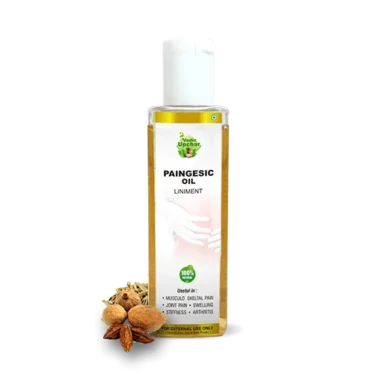
If you want a single topical that helps multiple musculoskeletal complaints, Paingesic oil, from Vedic Upchar is formulated as an Ayurvedic, multipurpose liniment to soothe joint pain, muscle aches, sprains and stiffness. This Yoast-friendly post explains what Paingesic oil, does, when to use it, how to apply it safely, and when to get a personalised consultation.
The problem
People commonly use many different products for back pain, knee pain, ankle sprain, shoulder stiffness and general body aches. The problem is inconsistent relief, confusing choices, and unwanted chemicals in some OTC gels. A single trusted topical—used correctly—can simplify care and speed recovery. Paingesic oil, aims to be that single, multi-use oil: topical, herbal, and suited to everyday pain management when combined with rest and movement therapy.
Why choose Paingesic oil, for many problems
Paingesic oil, is an Ayurvedic liniment that pairs warming and anti-inflammatory herbs in an oil base that penetrates skin and eases local symptoms. It’s useful as a supportive, symptomatic treatment for:
- Acute sprains and strains (ankle, wrist, shoulder)
- Muscle soreness after activity or exercise
- Chronic joint stiffness (knee, elbow) as a supportive topical
- Localised nerve-related pain (mild sciatica, neuralgias) alongside medical care
- Stiffness from sedentary work or long travel
Because it’s topical, Paingesic oil, works where you apply it — delivering fast local warmth, improving circulation and helping relax tight tissues.

Key ingredients & what they do (Ayurvedic benefits)
Paingesic oil, combines classic Ayurvedic botanicals chosen for musculoskeletal support. Typical herbs and actions include:
- Nirgundi (Vitex): analgesic & anti-inflammatory for joint/muscle pain.
- Bala (Sida cordifolia): strengthens muscle and connective tissue.
- Rasna & Turmeric: reduce inflammation and support tissue repair.
- Sesame or other herbal oil base: carries herbs deep, nourishes skin, and pacifies Vata (dryness/mobility imbalance).
These herbal actions make Paingesic oil, suitable for repeated topical use (with precautions below) as part of a broader care routine.
How to use Paingesic oil, — practical step-by-step
- Warm the oil: place the sealed bottle in hot water for 30–40 seconds (don’t overheat).
- Apply: pour 5–10 ml depending on area size.
- Massage: gentle circular strokes for 8–12 minutes, moving from the limb toward the heart to encourage circulation.
- Optional heat: follow with a warm compress for 10–15 minutes for deeper penetration.
- Frequency: once daily for maintenance; twice daily during acute flare-ups unless skin irritation occurs.
Simple at-home plan combining Paingesic oil, with self-care
- Acute sprain: RICE initially (rest, ice, compression, elevation) for first 24–48 hours; begin gentle Paingesic oil, massage after initial swelling reduces.
- Chronic joint stiffness: daily evening Paingesic oil, 10 minutes massage + 10 minutes warm compress. Add gentle mobility exercises.
- Post-exercise soreness: apply Paingesic oil, 20–30 minutes after cool-down and light stretching.
Safety & precautions
- Do not apply on open wounds, infected skin, or acute swelling with significant bruising until reviewed by a clinician.
- Patch test to check for allergy; stop if rash, burning or blistering occurs.
- Pregnancy & breastfeeding: consult your practitioner before use.
- Blood thinners or skin conditions: ask your doctor before regular topical herbal use.
- If pain is severe, progressive, involves fever, numbness, or loss of function — seek immediate medical attention; topical oil is supportive, not a substitute for urgent care.
When a single oil is not enough — red flags
If you have: uncontrollable pain after injury, inability to bear weight, sudden neurological signs (numbness, weakness), high fever, or suspected fracture — Paingesic oil, should be paused and you should get urgent medical / orthopaedic care.
Evidence & realistic expectations
Topical herbal liniments can relieve muscle tension and improve local circulation. Clinical outcomes depend on cause and severity — Paingesic oil, helps many people with muscular and mild joint pain, but chronic structural problems (advanced osteoarthritis, fractures, infections) need broader medical or surgical care. Use the oil as part of a plan: movement, physiotherapy, weight management and professional advice when needed.
When to get a consultation
For persistent pain, recurring injuries, or if you want a tailored plan (topical + internal herbs + physiotherapy or Panchakarma), get a consultation from Vedic Upchar:
👉 https://vedicupchar.com/doctor-consultation.
Our practitioners will assess your condition, advise massage technique and dosing, and coordinate additional therapies safely.
Quick checklist
- Patch test Paingesic oil, before first use.
- Warm, massage, and apply a warm compress for best effect.
- Use daily for stiffness; twice daily during flare-ups.
- Stop & consult if severe pain, fever or neurological signs appear.
- Book Vedic Upchar consultation for personalised care.